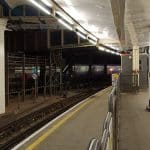Last Updated on 07/04/2023 by Alex Hamlyn
Table of Contents
Where was Leslie Green born?
Alright, I admit it. There is nothing about the Architect Leslie Green that that screams ‘Strange Britain’, but I noticed his name coming up again and again while writing about stations on the Tube, so I thought it only fitting that he be given his own article.
Leslie Green: Architect of the Underground
In the bustling metropolis of London, history is interwoven with the modern world, and the city’s Underground is no exception. When you descend into the depths of the Tube, you are not only stepping into an efficient transit system, but also into a world of architectural splendour that has stood the test of time.
One of the key figures behind the creation of this intricate network of stations is Leslie Green, a visionary architect who left an indelible mark on the cityscape.
Born in the late 19th century, Green’s pioneering work has come to symbolize a golden era in British architecture. His distinctive and innovative designs are still admired today, over a century after their conception.
This article will delve into the life and work of Leslie Green, exploring his unique approach to architecture, his enduring impact on London’s infrastructure, and the legacy he left behind.
Here you can uncover the fascinating story of the man who shaped the face of the London Underground and forged a lasting connection between style and function in the early 20th century.
Early Life, Education, and Early Work
Leslie William Green was born on June 6, 1875, in Maida Vale, London, to a family that valued creativity and craftsmanship. His father, William Green, was an accomplished goldsmith and engraver who inspired Leslie to develop an appreciation for design and precision early in his life.
Green’s formal education began at the prestigious Haberdashers’ Aske’s School in Hampstead, where his artistic talents began to emerge. He later attended the Royal Academy of Arts, where he honed his skills in drawing and design, gaining a strong foundation in classical architectural principles. It was during this period that he was exposed to the Beaux-Arts architectural style, which would later influence his own work.
After his time at the Royal Academy, Green sought practical experience to complement his academic background. He secured an apprenticeship with the eminent architect Sir Ernest George and his partner, Harold Peto. Under their tutelage, Green worked on a variety of projects, including residential buildings, commercial properties, and civic institutions. This period of hands-on experience allowed him to develop a keen understanding of construction techniques and materials, as well as an appreciation for the importance of blending aesthetics with practicality.
Green’s early work showcases his ability to create innovative and elegant solutions to architectural challenges. Some notable examples include the design of the Hampstead Garden Suburb, an early 20th-century planned community that emphasized green spaces and harmonious architecture, and the redevelopment of the Battersea Polytechnic Institute, a project that required the skilful integration of new facilities within a historic setting.
Though these early projects garnered Green recognition and respect within the architectural community, it was his later work on the London Underground that would truly cement his legacy. Nevertheless, his early life, education, and initial professional experiences laid the groundwork for his ground-breaking contributions to British architecture and urban design.
The Architect of the Underground – Leslie Green’s Impact on London’s Transport Network
The London Underground project marked a turning point in Leslie Green’s career, propelling him to the forefront of British architectural history.
In 1903, Green was appointed the chief architect for the Underground Electric Railways Company of London (UERL), which was responsible for the construction of three new tube lines: the Bakerloo, Piccadilly, and Hampstead (now part of the Northern Line).
Green’s first station was the now-iconic Oxford Circus, completed in 1906. It was here that his signature style, characterized by a combination of Beaux-Arts principles and the use of distinctive oxblood-red glazed terracotta tiles, truly began to take shape.
Beaux-Arts design principles and the London Underground
The Beaux-Arts architectural style originated in France during the late 19th and early 20th centuries. It is named after the École des Beaux-Arts (School of Fine Arts) in Paris, where many architects were trained in this style. Beaux-Arts principles emphasize classical aesthetics, grandeur, and elaborate ornamentation, drawing inspiration from historical Greek and Roman architecture as well as the Italian Renaissance. The style’s key principles are founded on symmetry, hierarchy, ornamentation, classical orders (for example in columns), axial planning and grand entrances.
This innovative choice of material not only provided a striking visual impact, but also offered a practical solution for ease of cleaning and maintenance.
Some of the finest examples of Green’s work can be seen at stations such as Covent Garden, Russell Square, and South Kensington. These stations showcase his flair for integrating elegant design with functional requirements, featuring gracefully arched windows, ornate ironwork, and the clever use of natural light.
Green’s designs also emphasized the importance of consistency, with many stations sharing similar layouts and design elements to create a cohesive visual identity for the Underground network.
While the majority of Green’s stations continue to serve London’s commuters, some have been decommissioned over the years. Notable examples include the original City Road and York Road stations on the Northern Line, both of which were closed in the early 20th century due to low passenger numbers.
Despite their closure, these stations still stand as testaments to Green’s architectural prowess, with some repurposed for alternative uses or maintained as heritage sites.
Through his innovative designs and commitment to practicality, Leslie Green succeeded in shaping the face of the London Underground. His signature style continues to leave an indelible mark on the cityscape, and his work stands as a testament to the enduring power of elegant design and functional excellence.
An Enduring Architectural Legacy – The Influence of Leslie Green
Leslie Green’s impact on the London Underground has left an indelible mark on the city, with his signature designs remaining iconic over a century after their creation. In total, Green designed 50 stations for the UERL, providing London with an architectural identity that continues to be admired and cherished to this day.
His pioneering work and innovative use of materials have inspired generations of architects and designers, both in the United Kingdom and around the world. Among his most notable admirers was Charles Holden, who went on to become one of Britain’s leading architects, responsible for designing numerous Underground stations in the 1920s and 1930s.
Green’s influence can also be seen in the work of Frank Pick, who led the London Underground’s expansion and design evolution from the 1920s to the 1940s.
An untimely death
Towards the end of his life, Leslie Green’s health began to decline, and he struggled with severe bouts of asthma and chronic illness. As a result, his ability to work was greatly affected, and he was unable to fully complete all of the projects he had initiated. He resigned from his position at the UERL in 1910 due to his deteriorating health.
Tragically, Leslie Green passed away at the young age of 33 on August 31, 1908. His untimely death left some of his work unfinished, and other architects took over the completion of certain projects.
However, even today his pioneering and distinctive style can still be seen at stations across the Underground network. Despite his relatively short career, Green’s innovative designs and contributions to the London Underground have left a lasting legacy, with his work continuing to be admired and celebrated more than a century after his passing.
Underground Stations designed by Leslie Green
| Station Name | Date Opened | Date Closed | Line |
| Aldwych (Strand) | 1907 | 1994 | Piccadilly |
| Baker Street | Bakerloo | ||
| Belsize Park | 1907 | Northern | |
| Borough | 1890 | Northern | |
| Brompton Road | |||
| Caledonian Road | 1906 | Piccadilly | |
| Camden Town | 1907 | Northern | |
| Chalk Farm | 1907 | Northern | |
| Charing Cross | 1906 | Bakerloo, Northern | |
| Clapham Common | 1900 | Northern | |
| Clapham North | 1900 | Northern | |
| Covent Garden | 1907 | Piccadilly | |
| Dover Street (Green Park) | 1906 | 1933 | Jubilee, Piccadilly, Victoria |
| Down Street | |||
| Edgeware Road | Bakerloo | ||
| Embankment | Bakerloo | ||
| Euston | 1907 | Northern | |
| Elephant & Castle | 1906 | Northern, Bakerloo | |
| Gillespie Road | |||
| Gloucester Road | |||
| Goodge Street | 1907 | Northern | |
| Great Central (Marylebone) | Bakerloo | ||
| Hampstead | 1907 | Northern | |
| Highgate (Archway) | 1907 | Northern | |
| Holborn | 1906 | Central, Piccadilly | |
| Holloway | |||
| Hyde Park Corner | |||
| Kennington | 1890 | Northern | |
| Kentish Town | 1907 | Northern | |
| King’s Cross St Pancras | 1906 | Circle, Hammersmith & City, Metropolitan, Northern, Piccadilly, Victoria | |
| Knightsbridge | |||
| Lambeth North | 1906 | Bakerloo | |
| Leicester Square | 1906 | Northern, Piccadilly | |
| Mornington Crescent | 1907 | Northern | |
| Oxford Circus | 1906 | Bakerloo, Central | |
| Piccadilly Circus | 1906 | Bakerloo, Piccadilly | |
| Regent’s Park | 1906 | Bakerloo | |
| Russell Square | 1906 | Piccadilly | |
| South Kensington | 1906 | Piccadilly | |
| South Kentish Town | |||
| Tottenham Court Road (Oxford Street) | |||
| Trafalgar Square | 1906 | 1999 | Bakerloo |
| Tufnell Park | 1907 | Northern | |
| Warren Street | 1907 | Northern, Victoria | |
| West End | 1907 | 1994 | Northern |
| Waterloo | |||
| York Road | 1906 | 1932 | Piccadilly |
Image credits
References
- https://en.wikipedia.org/wiki/Leslie_Green
- https://historicengland.org.uk/listing/enrich-the-list/leslie-green/
- https://www.mylondon.news/news/nostalgia/tragic-architect-over-50-london-21857434
- https://thebeautyoftransport.com/2013/10/09/the-green-agenda-leslie-green-underground-stations-london-uk/
- https://www.amazon.co.uk/Underground-Stations-Leslie-Green/dp/1854142550
- https://www.londonreconnections.com/2010/the-man-who-painted-london-red/
- https://www.londonremembers.com/subjects/leslie-green


